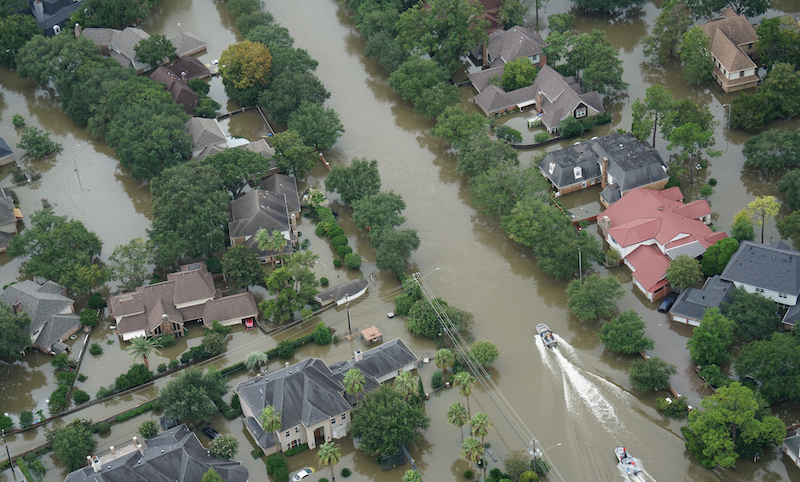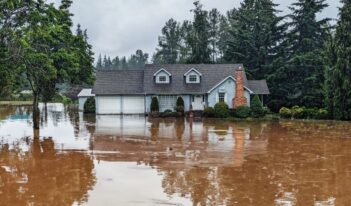
As global temperatures rise, Americans will continue to pay the economic costs of climate change.
Americans would be outraged if the federal income tax system operated like a reverse lottery—with the Internal Revenue Service randomly seizing only a subset of the population’s property and forcing others to lose their homes, while the rest of us escaped from paying anything. And yet, that is how the nation deals with the costs of climate change.
Like a tax, climate change’s costs impose a burden on the economy—and on the lives and well-being of American families. So long as policymakers resist adopting sensible climate legislation, these costs amount to a hidden climate tax—and one that is imposed haphazardly on those who happen to be unlucky enough to suffer the ravages of extreme weather events and other climate-related harms.
Just this past year, Hurricanes Florence and Michael tore up the nation’s coastlines, leading to billions of dollars in private property losses. According to initial estimates, just three of California’s major forest fires from 2018 resulted in at least $9 billion in property losses, as tens of thousands of homes and other buildings went up in flames. These costs will only increase with time, as scientists predict climate change will make the frequency and severity of such events worse. Nine of California’s 10 largest fires took place in roughly the past 15 years.
According to a National Climate Assessment report released by the federal government last year, climate change can be expected to place an enormous drag on the U.S. economy throughout this century—upward of an estimated $500 billion in costs per year due to crop losses, coastal flooding and health risks, among other harms. Under some scenarios, this hidden climate tax could result in an annual 10 percent reduction in gross domestic product by the end of the century.
The current American climate tax is not only huge and growing but also erratic and unfair. Although everyone contributes to climate change through the use of energy, not everyone pays the climate tax in proportion to what they contribute. After all, the path any particular storm takes, or the direction that a wildfire spreads, depends on forces other than its victims’ energy usage. And those who lose their lives pay the ultimate price: Hurricanes Michael and Florence killed 43 and 53 people, respectively, and the Camp Fire in California claimed 86.
The nation’s climate tax bill comes due in other ways, too. At one point last year, residents of San Francisco were forced to breathe the worst air quality in the world due to rampant forest fires. The costs of hospital admissions, lost days of work, and exacerbated cases of asthma all have to be paid by someone.
Plus, climate change’s costs pose a threat to national security. When Michael hit Florida, it destroyed large swaths of Tyndall Air Force Base and inflicted damage to a fleet of fighter jets—an immediate hit to military readiness and a huge cost that ordinary tax dollars will have to repay. More broadly, the U.S. military recognizes that climate change can exacerbate conflicts and humanitarian crises abroad.
Democrats who recently regained the majority in the House of Representatives say they want to tackle climate change. The last time Democrats regained the majority in the House, in 2007, they said the same thing, and they worked to pass legislation that would have created a market-based system for trading credits in greenhouse-gas emissions. This innovative legislation would have placed an overall cap on emissions but then basically divided the overall legally permitted amount among existing firms and allowed companies to buy and sell their shares with each other.
Economists have long recommended emissions trading as a cost-effective solution to environmental problems. Yet back in 2009, the cap-and-trade bill that passed the House eventually stalled in the Senate, in no small part because Republicans succeeded in tarring it as a “cap-and-tax” plan. They charged that any regulation of greenhouse-gas emissions would operate as a burdensome tax on industry, dragging down the economy and costing workers their jobs.
The Republican critics were wrong about the economic effects of the cap-and-trade system, as studies have shown that environmental regulations have no meaningful effects on aggregate employment. But Republicans were clearly correct as a matter of political rhetoric: Few Americans like taxes, so labeling the Democratic environmental legislation as a tax helped secure its demise.
Today, government action is needed more than ever to address the ill effects of climate change. The U.S. economy generates more carbon dioxide emissions than any country other than China, and we need U.S. leadership to sustain global climate efforts. Although legislation can never eliminate all instances of extreme weather, sound policy would help reduce the frequency and severity of such events as well as lower climate change’s other costs.
As House Democrats turn to develop a climate strategy in the coming months, they would increase their chances of success if they seized the rhetorical initiative and made clear that doing nothing leaves Americans paying a tax, too: one that is hidden, unfair and ever-increasing. Call it the do-nothing climate tax.
A version of this essay appeared in The Washington Post on January 23, 2019.





